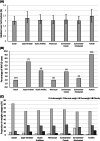Ethnic disparities in liver fat accumulation in school-aged children
- PMID: 35785476
- PMCID: PMC9546249
- DOI: 10.1002/oby.23478
Ethnic disparities in liver fat accumulation in school-aged children
Abstract
Objective: Nonalcoholic fatty liver disease (NAFLD) has a different prevalence in adults from different ethnic groups. This study examined whether these ethnic differences originate in early life and could be explained by early-life factors.
Methods: This observational study was embedded in a population-based prospective cohort study from fetal life onward among 2,570 children born in Rotterdam, the Netherlands. Information about prepregnancy, pregnancy, and childhood factors, as well as childhood BMI, was obtained from questionnaires and physical examinations. Liver fat was assessed by magnetic resonance imaging at age 10 years.
Results: Median liver fat fraction was 2.0% (95% CI: 1.2%-5.3%), and NAFLD prevalence was 2.8%. Children from a Turkish background had the highest median liver fat percentage (2.5%, 95% CI: 1.2%-10.7%) and NAFLD prevalence (9.1%). Children of Cape Verdean, Dutch Antillean, Surinamese-Creole, or Turkish background had a higher total liver fat fraction compared with children with a Dutch background (p < 0.05). After controlling for early-life factors, these differences persisted only in children with a Turkish background.
Conclusions: Prevalence of liver fat accumulation and NAFLD differs between ethnic subgroups living in the Netherlands, especially for those with a Turkish background. Early-life factors have a strong influence on these associations and may hold clues for future preventive strategies.
© 2022 The Authors. Obesity published by Wiley Periodicals LLC on behalf of The Obesity Society (TOS).
Conflict of interest statement
The authors declared no conflict of interest.
Figures

References
-
- Bellentani S, Marino M. Epidemiology and natural history of non‐alcoholic fatty liver disease (NAFLD). Ann Hepatol. 2009;8(suppl 1):S4‐S8. - PubMed
-
- Schwimmer JB, Deutsch R, Kahen T, Lavine JE, Stanley C, Behling C. Prevalence of fatty liver in children and adolescents. Pediatrics. 2006;118:1388‐1393. - PubMed
Publication types
MeSH terms
LinkOut - more resources
Full Text Sources
Medical

